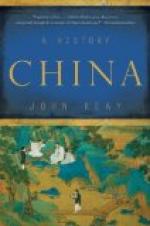p. 298: For K’ang Yo-wei, I use work done by O. Franke and others. See M.E. Cameron, The Reform Movement in China, 1898-1921, Stanford 1921. The best bibliography for this period is J.K. Fairbank and Liu Kwang-ching, Modern China: A Bibliographical Guide to Chinese Works, 1898-1937, Cambridge, Mass., 1950. The political history of the time, as seen by a Chinese scholar, is found in Li Chien-nung, The Political History of China 1840-1928, Princeton 1956.—For the social history of this period see Chang Chung-li, The Chinese Gentry, Seattle 1955.—For the history of Tz[)u] Hsi Bland-Backhouse, China under the Empress Dowager, Peking 1939 (Third ed.) is antiquated, but still used. For some of K’ang Yo-wei’s ideas, see now K’ang Yo-wei: Ta T’ung Shu. The One World Philosophy of K’ang Yu Wei, London 1957.
Chapter Eleven
p. 305: I rely here partly upon W. Franke’s recent studies. For Sun Yat-sen (Sun I-hsien; also called Sun Chung-shan) see P. Linebarger, Sun Yat-sen and the Chinese Republic, Cambridge, Mass., 1925 and his later The Political Doctrines of Sun Yat-sen, Baltimore 1937.—Independently, Atatuerk in Turkey developed a similar theory of the growth of democracy.
p. 306: On student activities see Kiang Wen-han, The Ideological Background of the Chinese Student Movement, New York 1948.
p. 307: On Hu Shih see his own The Chinese Renaissance, Chicago 1934 and J. de Francis, Nationalism and Language Reform in China, Princeton 1950.
p. 310: The declaration of Independence of Mongolia had its basis in the early treaty of the Mongols with the Manchus (1636): “In case the Tai Ch’ing Dynasty falls, you will exist according to previous basic laws” (R.J. Miller, Monasteries and Culture Change in Inner Mongolia, Wiesbaden 1959, p. 4).
p. 315: For the military activities see F.F. Liu, A Military History of Modern China, 1924-1949, Princeton 1956. A Marxist analysis of the 1927 events is Manabendra Nath Roy, Revolution and Counter-Revolution in China, Calcutta 1946; the relevant documents are translated in C. Brandt, B. Schwartz, J.K. Fairbank, A Documentary History of Chinese Communism, Cambridge, Mass., 1952.
Chapter Twelve
For Mao Tse-tung, see B. Schwartz, Chinese Communism and the Rise of Mao, second ed., Cambridge, Mass., 1958. For Mao’s early years; see J.E. Rue, Mao Tse-tung in Opposition, 1927-1935, Stanford 1966. For the civil war, see L.M. Chassin, The Communist Conquest of China: A History of the Civil War, 1945-1949, Cambridge, Mass., 1965. For brief information on communist society, see Franz Schurmann and Orville Schell, The China Reader, vol. 3, Communist China, New York 1967. For problems of organization, see Franz Schurmann, Ideology and Organization in Communist China, Berkeley 1966. For cultural and political problems, see Ho Ping-ti, China in Crisis, vol. 1, China’s Heritage and the Communist Political System, Chicago 1968. For a sympathetic view of rural life in communist China, see J. Myrdal, Report from a Chinese Village, New York 1966; for Taiwanese village life, see Bernard Gallin, Hsin Hsing, Taiwan: A Chinese Village in Change, Berkeley 1966.




